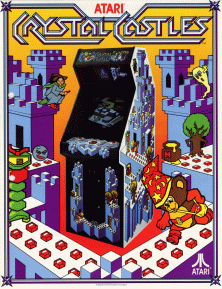
Crystal Castles is an arcade game released by Atari, Inc. in 1983. The player controls Bentley Bear who has to collect gems located throughout trimetric-projected rendered castles while avoiding enemies, some of whom are after the gems as well. Crystal Castles is one of the first arcade action games with an ending, instead of continuing indefinitely, looping, or ending in a kill screen, and to contain advance warp zones.
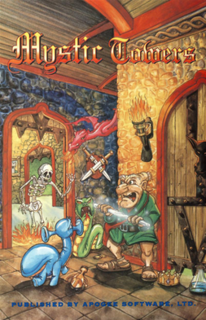
Mystic Towers is a video game created by Australian developer Animation F/X and published by Manaccom domestically and Apogee Software internationally. Originally exclusive to DOS, it was re-released on Steam in 2015 with Windows and Mac OS support. It stars Baron Baldric, an old wizard with a magic staff and an array of amusing mannerisms, who must quest through twelve towers and rid them of monsters. Mystic Towers is a sequel to Baron Baldric: A Grave Adventure, a platform game in which Baron Baldric battled an evil sorcerous ancestor. The earlier game, originally written for the Amiga and later ported to the PC, was published by Manaccom and not released outside of Australia.

Venture is a fantasy-themed action game released in arcades in 1981 by Exidy. The goal of Venture is to collect treasure from a dungeon as a round smiley-face named Winky. It was released as a launch title for the ColecoVision in 1982, then ported to the Atari 2600 and Intellivision.
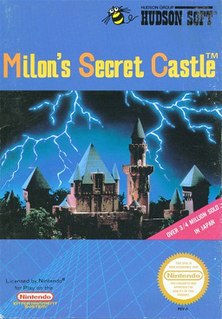
Milon's Secret Castle, known in Japan as Meikyū Kumikyoku: Milon no Daibōken, is a 1986 action-adventure game released by Hudson Soft for the NES. A Game Boy version was released in 1993. A sequel, DoReMi Fantasy, was released in 1996 for the Super Famicom.

Montezuma's Revenge is a 1984 platform game for Atari 8-bit family, Atari 2600, Atari 5200, Apple II, ColecoVision, Commodore 64, IBM PC, and ZX Spectrum. It was designed and programmed by Robert Jaeger and published by Parker Brothers. The game's title references a colloquial expression for diarrhea contracted while visiting Mexico.

Back to the Future Part II & III is a 1990 video game for the Nintendo Entertainment System based on the second and third films in the Back to the Future trilogy. The game was produced by Beam Software and published by Acclaim Entertainment under their LJN label.
The Eggerland (エッガーランド) series consists of several puzzle games developed by HAL Laboratory. Its first release was in 1985 for MSX computer systems. Many titles were made in the series and the gameplay is almost exactly the same in every game as well. Only a few changes were made over the years.

Jungle Run is a British children's television adventure series that aired on CITV as part of the ITV network from 10 September 1999 to 29 November 2006. It was a game show similar to shows such as Fort Boyard and The Crystal Maze. The show has had three presenters, referred to as the "Jungle Guide": Dominic Wood from 1999 to 2000, Chris Jarvis from 2001 to 2002 and Michael Underwood from 2003 to 2006. It was recorded at the disused air base, RAF Newton, near Nottingham.
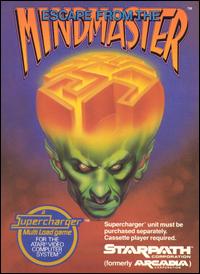
Escape from the MindMaster was a video game for the Starpath Supercharger addon for the Atari 2600 published in 1982 by Starpath.

Space Dungeon is a multidirectional shooter released in arcades by Taito in 1981. Designed and programmed by Rex Battenberg, it was available both as a conversion kit and full arcade cabinet. An Atari 5200 port was released in 1983.

Labyrinth is an action-adventure game published in 1984 by Acornsoft for the BBC Micro. Its author, Michael Mathison, describes it as:
an amalgam of what I'd seen and liked visually and I wanted to make something like an 'arcade' version of an adventure game - with lots of creatures and lots of running around shooting at things but also with some simple puzzle elements.

Advanced Dungeons & Dragons is an Intellivision game; it was one of the first Advanced Dungeons & Dragons games to be licensed by TSR, Inc. It was later retitled to Advanced Dungeons & Dragons: Cloudy Mountain to distinguish it from the sequel, Advanced Dungeons & Dragons: Treasure of Tarmin. It is the first Intellivision cartridge to use more than 4K of ROM.

Monster House is a third-person shooter survival horror video game developed by Artificial Mind and Movement and published by THQ. The game is based on the 2006 animated film of the same name. The game was met with mixed reception.

Gex: Enter the Gecko is a 1998 platform game and the second installment of the Gex video game series, released in 1998 and 1999 for the PlayStation, Nintendo 64, Microsoft Windows, and Game Boy Color. Its protagonist, Gex, a TV-binging, wisecracking gecko, is voiced by Dana Gould in the North American version, Leslie Phillips in the European release, and Mitsuo Senda in the Japanese release. Gex seeks to collect three types of remotes to unlock different TVs in the overworld that aid in the fight against his arch-nemesis, Rez.

Godzilla is a video game developed by Compile based on the Godzilla franchise, and was first released for Game Boy in 1990. It is a port of the 1985 MSX game, Gojira-Kun. The game features character designs from the franchise's Showa era films.

Estate of Panic is an American reality competition show in which seven strangers compete to find cash in a large estate. The show is hosted by Steve Valentine, and produced by Endemol USA.
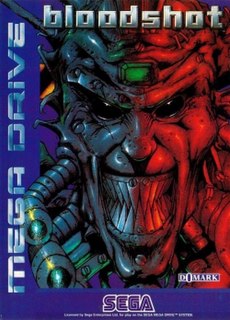
Bloodshot, also released as Battle Frenzy, is a video game developed by Jim Blackler for Domark and published by Acclaim in 1994 for the Mega Drive and the Mega-CD in Europe. A North American release was planned, and reviewed in gaming magazines, but was only released through the Sega Channel service.

Mountain King is a scrolling platform game released by CBS Electronics in 1983. It was available on the Atari 2600, Atari 5200, Atari 8-bit family, ColecoVision, Commodore 64, and VIC-20.

Dungeon of the Endless is a roguelike tower defense game developed by Amplitude Studios. It is the third game of their loosely connected Endless series, which includes Endless Space and Endless Legend. It was released in October 2014 for Microsoft Windows and Mac OS X systems, August 2015 for iOS devices, and for Xbox One in March 2016. The PlayStation 4 and Nintendo Switch ports were released in May 2020. A revamped version for iOS and Android devices, called Dungeon of the Endless: Apogee, launched on March 16, 2021.
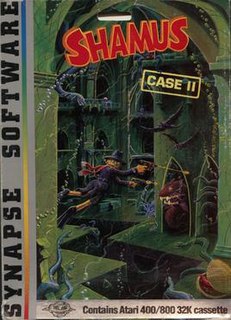
Shamus: Case II is a 1983 video game for the Atari 8-bit family written by Cathryn Mataga and published by Synapse Software. Mataga also wrote the original Shamus and the scrolling shooter Zeppelin. A port to the Commodore 64 by Joe Vierra was released in 1984. Although ostensibly a sequel to Shamus, the gameplay is very different, combining aspects of platform games, maze games, and even Breakout. Case II was as well received as the original.



















